The sight of potato leaves turning yellow can be alarming for any potato grower. A plant’s leaf is a vital indicator of its health. So, yellow leaves can signal underlying issues that require attention to prevent further damage and ensure a successful harvest.
Let’s explore 13 possible reasons why potato leaves turn yellow and provide practical solutions to prevent and address these problems effectively!
Contents
Why Are Potato Leaves Turning Yellow?
Here, we will discuss a variety of causes of the yellowing of potato leaves, and provide insights and mitigation strategies for each. Let’s start with the natural cause of the yellowing.
1. Ready for Harvest
One possible reason that causes yellow leaves is that the potato plant is nearing maturity and is ready for harvest:
- As the tubers develop and reach their full size, the plant starts redirecting its energy toward the quality tubers,
- Resulting in the yellow leaves and eventual death of the foliage.
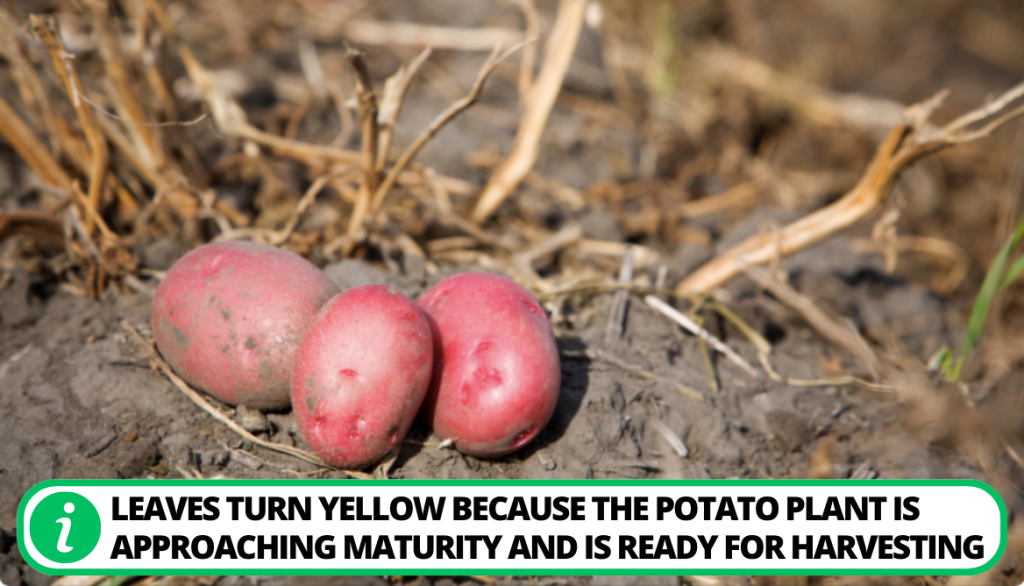
2. Not Enough Sun
Potatoes require an adequate amount of sunlight to thrive. If your potato plants do not receive it sufficiently potato plant leaves can turn yellow.
- The reason for this is that plants don’t produce enough energy through photosynthesis leads.
- As a result of nutrient deficiencies, stunted growth, and foliage yellowing.
3. Too Much Water
Overwatering can also cause the yellowing of leaves in the entire plant. Excess water in the soil can lead to poor drainage and root suffocation, resulting in reduced nutrient uptake and poor plant growth.
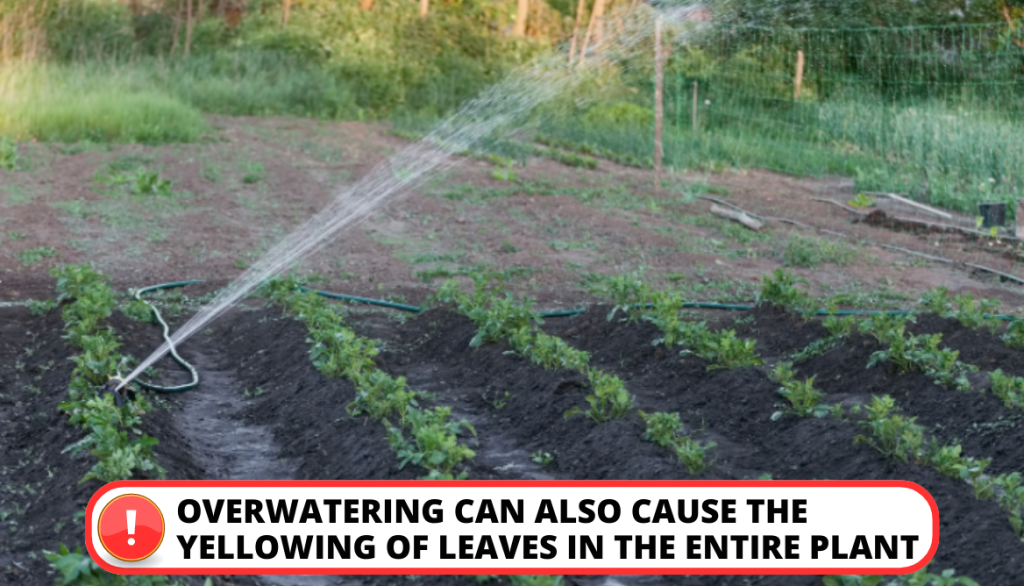
4. Magnesium Deficiency
A lack of magnesium in the soil can cause the yellowing of your plant leaves. Magnesium is an essential nutrient for chlorophyll production, and magnesium deficiency can impair the plant’s ability to carry out photosynthesis effectively.
As a result, the entire leaf may display interveinal yellowing, where the leaf tissue between the veins remain green or pale green while the leaf veins themselves stay yellow.
5. Nitrogen Deficiency
Insufficient nitrogen in the soil can lead to yellowing leaves. Nitrogen is crucial for potato plant growth and leaf development. When the soil lacks sufficient nitrogen, the potato crop may not be able to produce chlorophyll, resulting in yellow leaves.
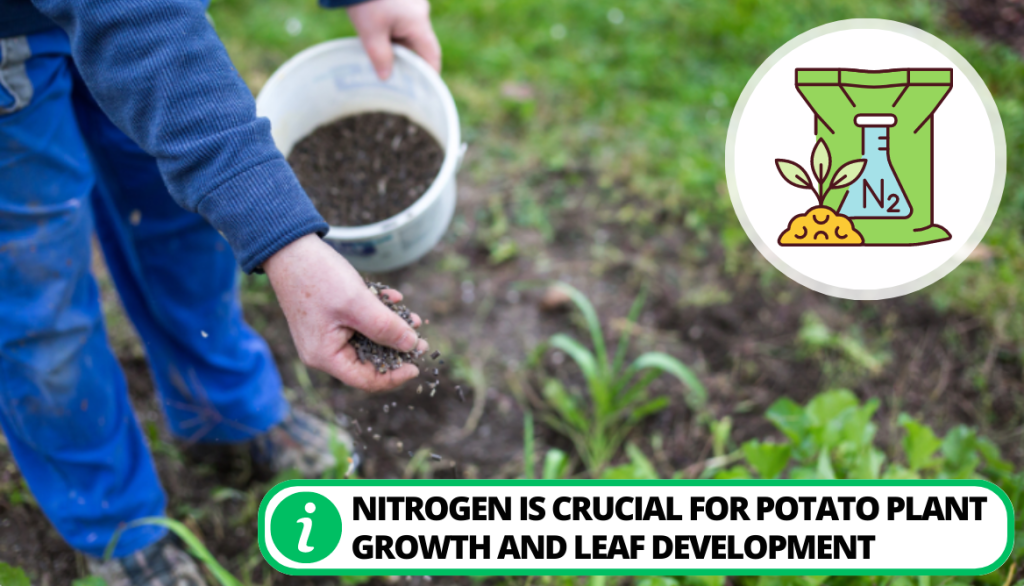
6. Too Much Nitrogen
While nitrogen deficiency can cause yellowing potato leaves, too much nitrogen can also cause this. The current condition known as nitrogen toxicity or nitrogen burn, occurs when the potato plant’s capacity to absorb and utilize nitrogen is overwhelmed.
7. Potassium Deficiency
Potatoes require potassium for various physiological functions, including root development, water regulation, and disease resistance. A lack of potassium in your garden soil can lead to yellowing leaves, starting from the tips and progressing toward the center of the foliage.
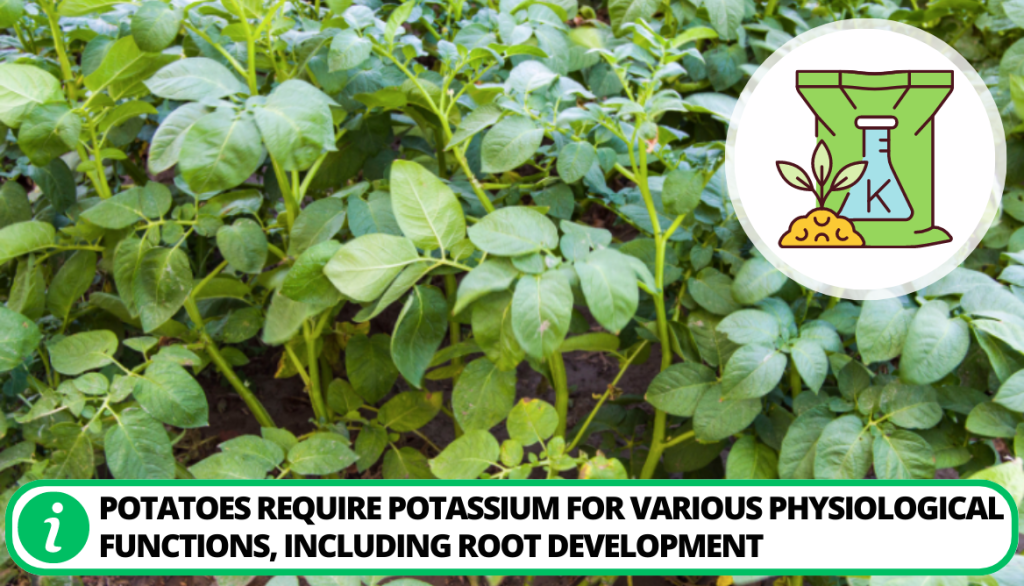
8. Verticillium Wilt
This is a fungal disease caused by the soil-borne pathogen Verticillium dahliae. This disease restricts the flow of water and nutrients in the plant making the leaves turn yellow, wilting, and eventually death of the leaves.
- Practice the rotation of crops;
- Avoid growing potatoes in infected areas;
- Choose disease-resistant potato varieties.
You should also apply fungicides as recommended by experts, as this can also help control to spread of the disease.
9. Fusarium Wilt
Fusarium wilt is also one of the fungal diseases that can make potato plants turn yellow. Fusarium wilt is caused by the fungus Fusarium oxysporum.
The pathogen attacks the potato plant’s vascular system, impeding water and nutrient transport. This wilt makes the plant’s leaves turn yellow, wilt, and even necrosis.
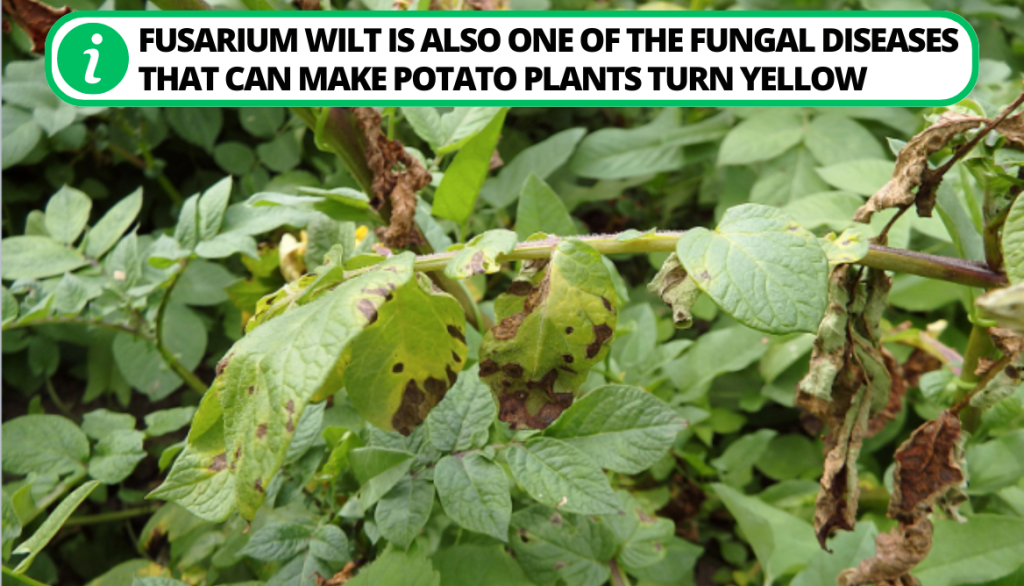
10. Potato Cyst Nematodes
Potato cyst nematodes are microscopic roundworms that feed on the roots of potato plants. Infestation by these pests can make potato plants turning yellow with stunted growth and reduced yields. The nematodes damage the root system, impeding nutrient uptake and water absorption.
11. Potato/Tomato Psyllid
The potato/tomato psyllid is an insect that can transmit a bacterium called “Candidatus Liberibacter solanacearum”. It causes a disease known as “psyllid yellows.” Infected potato plants may exhibit:
- Yellowing leaves;
- Purpling of leaf veins;
- Stunted growth;
- Reduced yield.
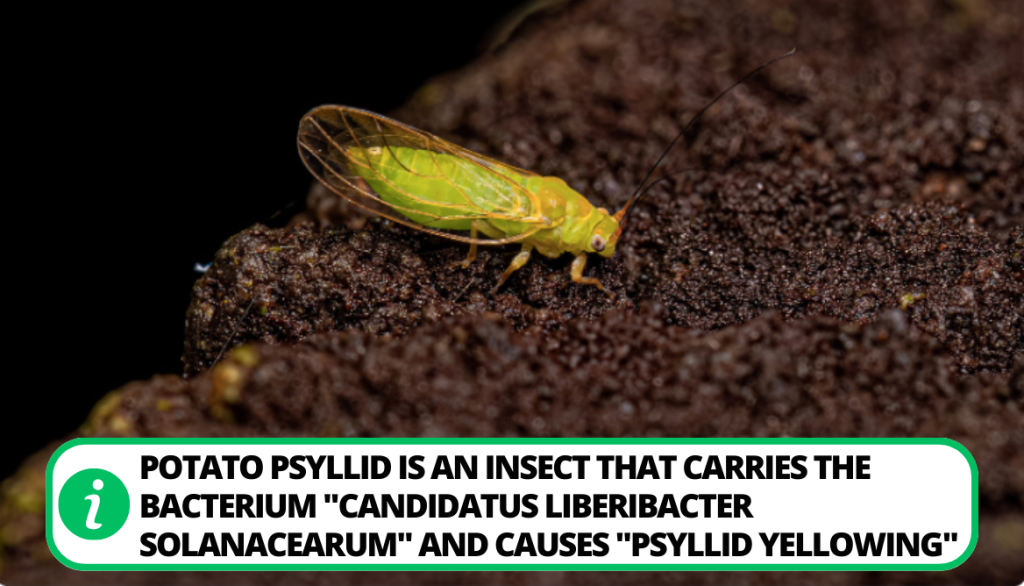
- To monitor plants for signs of infestation;
- Remove and destroy affected plants;
- Consider using insecticides labeled for psyllid control.
12. Potato Blight
The oomycete pathogen Phytophthora infestans cause late blight. It is a severe disease that can affect potato plants. Infected plants may display:
- Yellowing leaves;
- Brown lesions;
- White, fuzzy growth on the undersides of leaves.
Late blight can rapidly spread and cause significant crop damage.
- Choose certified seed potatoes that are resistant to late blight diseases.
- Practice proper potato crop spacing.
- Apply fungicides according to the recommended schedule and dosage.
13. Pest and Diseases
Aphids, mites, leafhoppers, colorado potato beetles, spider mites, leaf miners, and other insect pests can damage the foliage, causing yellowing and deformation of crop leaves. Diseases such as early blight, and viral infections like Potato Leafroll Virus can also lead to leaf yellowing.
The symptoms of Potato Leafroll Virus infection include:
- Yellowing and curling of the leave;
- Necrotic or dead patches on the leaves.
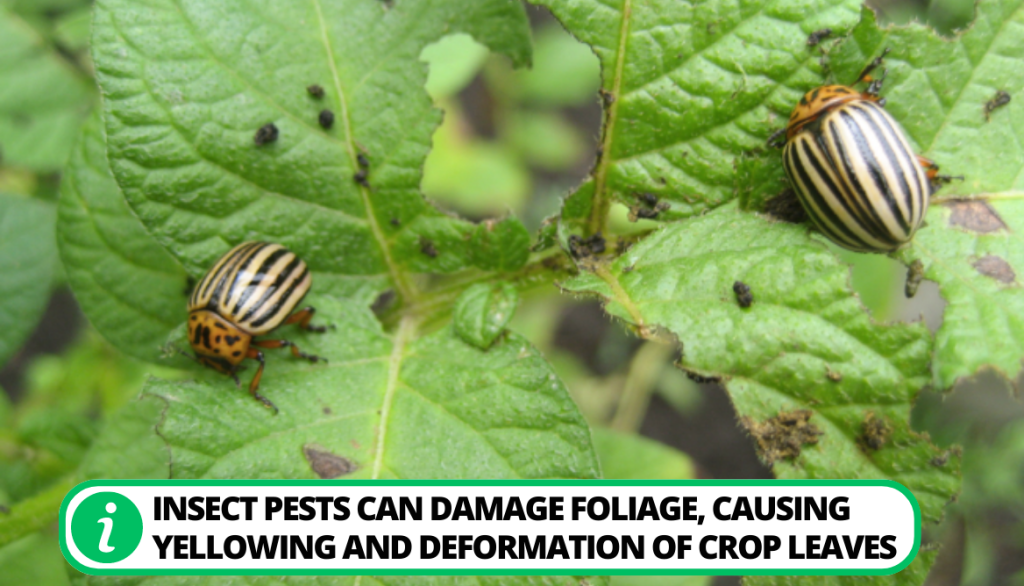
- Physical removal;
- Insecticides;
- Disease-resistant varieties.
How to Prevent and Treat Yellowing Potato Leaves
The yellowing of leaves can be caused by several factors. To prevent and treat the yellowing of leaves, in potato crops, here are some steps you can take;
1. Soil Testing and Fertilization
To understand why potato leaves turn yellow, it is crucial to test your soil. By analyzing the soil composition, nutrient deficiencies can be identified and addressed through proper fertilization.
Adding the necessary nutrients, such as nitrogen, phosphorus, and potassium, can help maintain the health and vibrant green color of leaves.
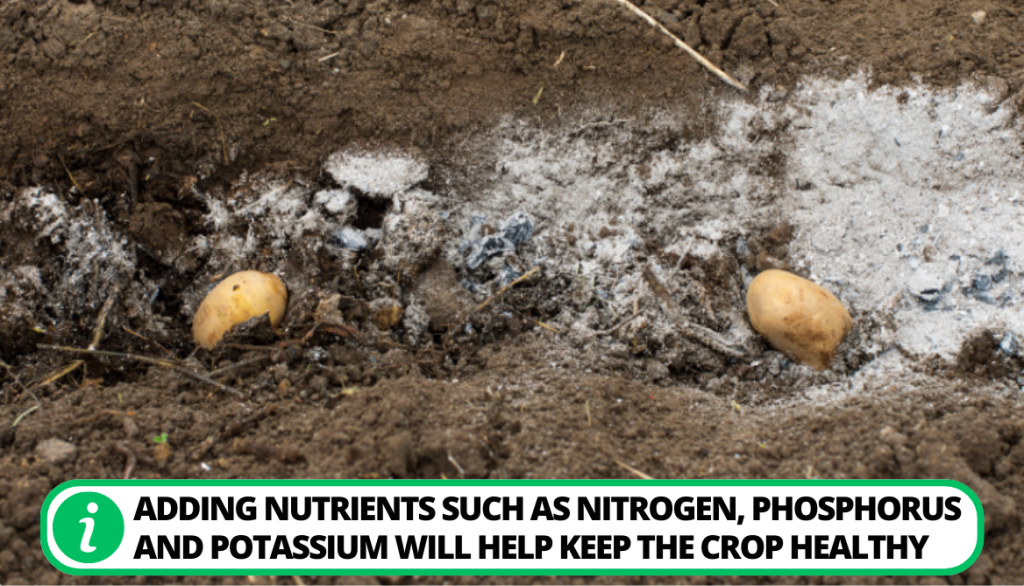
2. Proper Watering Techniques
Watering plays a crucial role in potato plants turning yellow. Overwatered plants or underwatered plants can be stressed and have nutrient imbalances, resulting in leaf discoloration.
Implementing proper watering techniques, such as maintaining consistent soil moisture and avoiding waterlogged conditions, can help prevent leaves from turning yellow.
3. Use of Pesticides or Natural Pest Control Methods
When choosing pesticides to control pests that make potato plants turning yellow, it is crucial to consider the specific pests involved and follow expert advice. Here are a few recommendations;
- Insecticides: Some commonly used pesticides for potatoes include insecticides like spinosad, neem oil, pyrethrin, and Bacillus thuringiensis (Bt).
- Fungicides: For fungal diseases, fungicides like copper-based fungicides, mancozeb, and chlorothalonil are commonly used to treat plants leave turning yellow.
- Safety measures: Integrated Pest Management practices should be incorporated alongside pesticide use to minimize environmental impact and promote sustainable pest management.
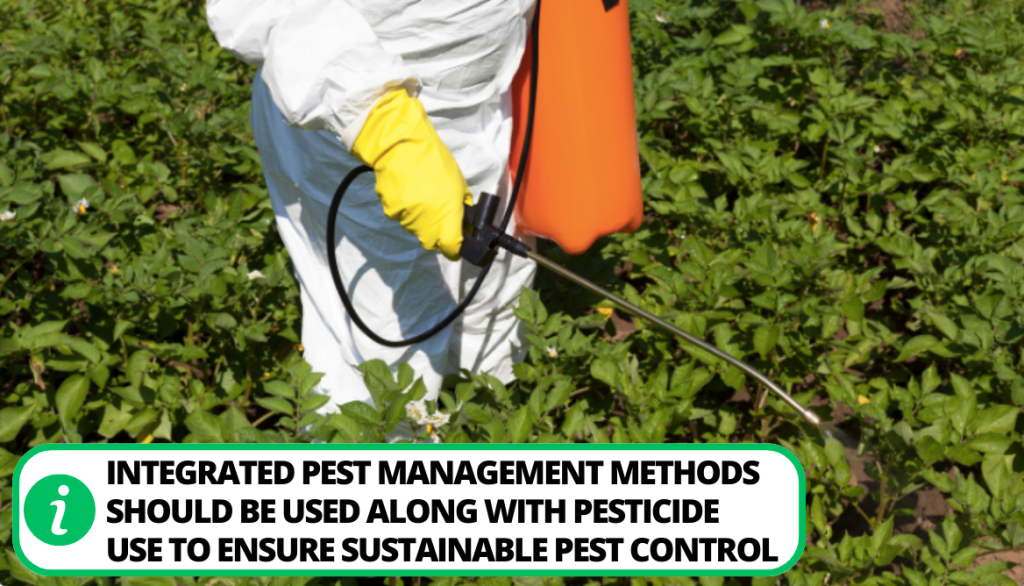
Natural Pest Control Alternatives
There are several natural pest control methods that can be employed, which are:
- Colorado potato beetle control: Handpicking, using sticky traps, and planting trap crops like nasturtiums.
- Aphid control: Introducing beneficial insects like ladybugs or using homemade insecticidal soap spray.
- Nematode control: Crop rotation with non-susceptible plants and planting marigolds as cover crops or companions.
- Leafhopper control: Vacuuming or spraying off leafhoppers and planting aromatic herbs nearby.
- Slugs and snails control: Creating physical barriers and using beer traps or handpicking.
- Leaf miner control: The use of parasitoid wasps and flies that specifically target leaf miner larvae, and mites.
4. Providing Shade During Extreme Heat
Extreme heat can contribute to stress and yellowing of leaves in potatoes. To prevent this, providing shade during hot weather conditions can help protect the plants from excessive heat and sun exposure.
Structures that can assist in maintaining optimal growing conditions and prevent potatoes from turning yellow:
- Using shade cloth;
- Plant covers;
- Creating shade with taller crops.

5 Best Practices for Fertilizer Application to Prevent Yellowing in Potato Plants
Proper fertilization is crucial for maintaining healthy plants and preventing issues that make potato plant’s leaves turn yellow.
1. Nutrient Analysis Of The Soil
Before applying fertilizers, it is essential to conduct a soil test and nutrient analysis. This analysis helps determine the nutrient deficiencies or excesses in the soil, allowing for targeted fertilization. Soil testing can be performed by a professional laboratory or using home test kits.
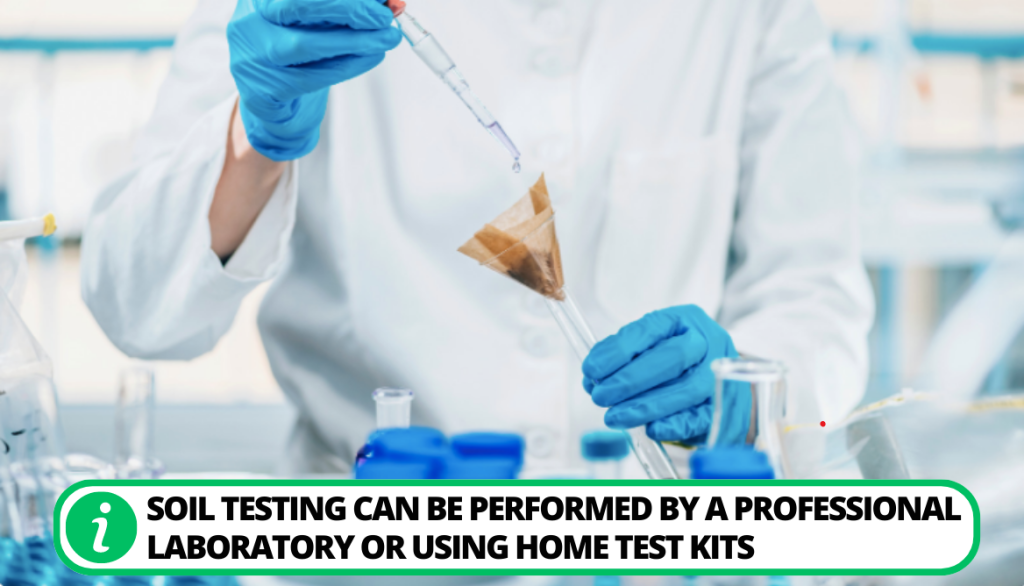
2. Understanding Macronutrient and Micronutrient Needs
Potatoes require three primary macronutrients which are nitrogen (N), phosphorus (P), and potassium (K).
- When fertilizing potatoes, the ratio of these three nutrients will depend on the specific nutrient needs of the soil, as determined by a soil test.
- The most commonly recommended ratio is 2:3:3, representing the N:P:K ratio.
- This means that if you’re applying a total of 100 pounds of fertilizer, 20 pounds would be nitrogen, 30 pounds of phosphorous, and 30 pounds of potassium.
In addition to macronutrients, potatoes require various micronutrients for optimal growth. Micronutrient deficiencies such as iron, can lead to yellowing leaves. It is important to address any identified micronutrient deficiencies through targeted fertilizer applications or foliar sprays.
3. Fertilizer Types and Formulations
Potato fertilizers are available in various forms, including granular, liquid, and organic options.
- Choosing the appropriate fertilizer formulation for your soil depends on factors such as your soil type, nutrient requirements, and availability.
- It is crucial to select a fertilizer that releases nutrients gradually to avoid nutrient imbalances or leaching.
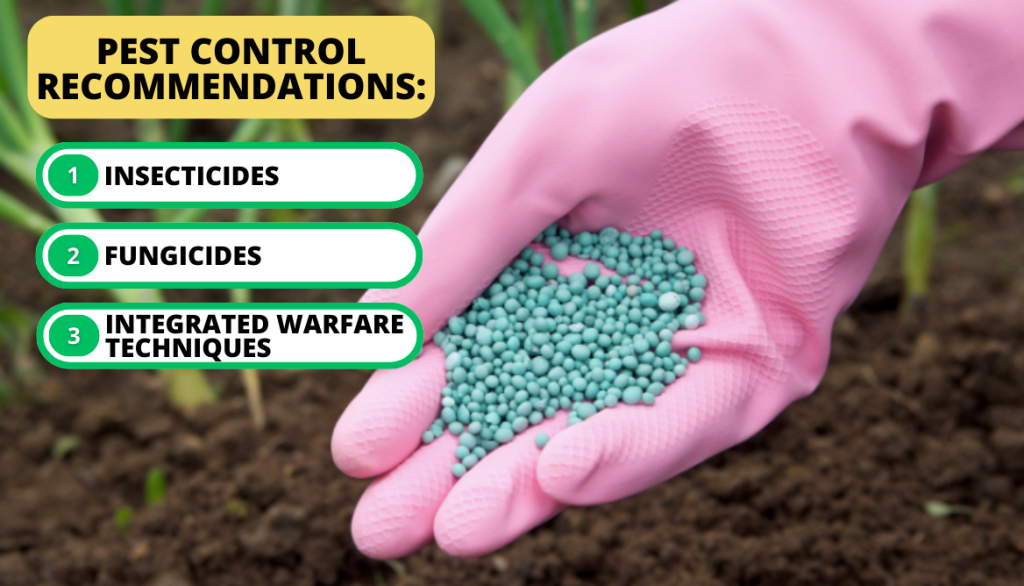
4. Fertilizer Application Methods
You can use the following method;
- Pre-Planting: Incorporate a balanced fertilizer into the soil before sowing the potato plants, based on soil test recommendations. This helps establish a nutrient-rich environment for the potato plants.
- Side-Dressing: Apply additional fertilizers alongside the rows or around the plants during the growing season. This provides a supplementary nutrient boost as the plants mature.
- Foliar Feeding: In cases of severe nutrient deficiencies or quick nutrient absorption requirements, foliar sprays can be used. These sprays deliver nutrients directly to the leaves, bypassing potential soil nutrient limitations.
5. Timing And Monitoring
Before applying any fertilizer, take into account that the timing and frequency of applications will depend on:
- The fertilizer type;
- Crop stage;
- Soil conditions.
Regular monitoring of your potato plant health, nutrient deficiency, and environmental conditions is essential. Observing plant response and conducting follow-up soil tests can help identify nutrient imbalances or deficiencies. This ensures the plants receive adequate nutrients without causing harm.
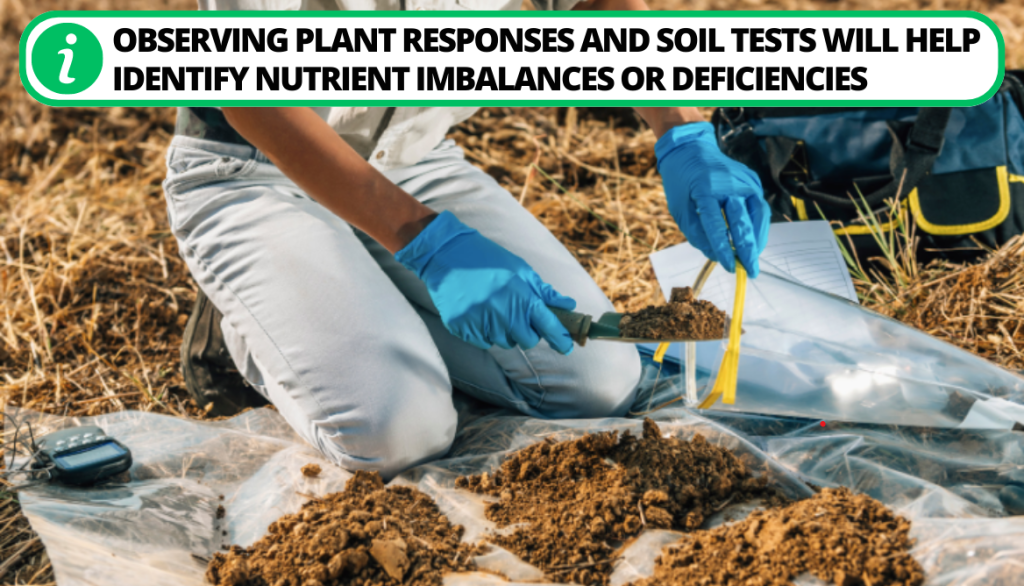
The Importance of Potatoes in Agriculture
Potatoes are not only a staple food crop for millions of people around the world but also a vital source of income for farmers. However, the importance of potatoes goes beyond mere consumption and economic benefits.
- High output: Potatoes have a high yield potential compared to many other crops, making them an efficient and productive option for farmers.
- Extended shelf life: Potatoes also have a long shelf life, making them valuable in regions with inadequate storage facilities or unreliable transportation networks.
- Nutritional value: Potatoes are known for their versatility and nutritional value, providing essential carbohydrates, vitamins such as Vitamin C and B6, fiber, potassium, iron, and minerals.
- Wide Adaptability: Potatoes are adaptable to diverse climatic conditions and can be grown in various environments, ranging from high-altitude regions to coastal areas.
- Industrial Use: Potatoes have extensive industrial applications beyond food consumption. They are used in the production of starch, chips, fries, flakes, and various processed products. These industries contribute to the economy and provide additional markets for potato farmers.
- Seed production: Potatoes are propagated vegetatively through tubers rather than seeds. This characteristic allows for the efficient multiplication of seed material, enabling small-scale farmers to save and replant a portion of their harvest for subsequent seasons.
- Food diversity: Incorporating potatoes into agricultural systems adds dietary diversity to communities. They complement other food crops and can contribute to balanced diets by providing essential nutrients and can play a crucial role in combating malnutrition.
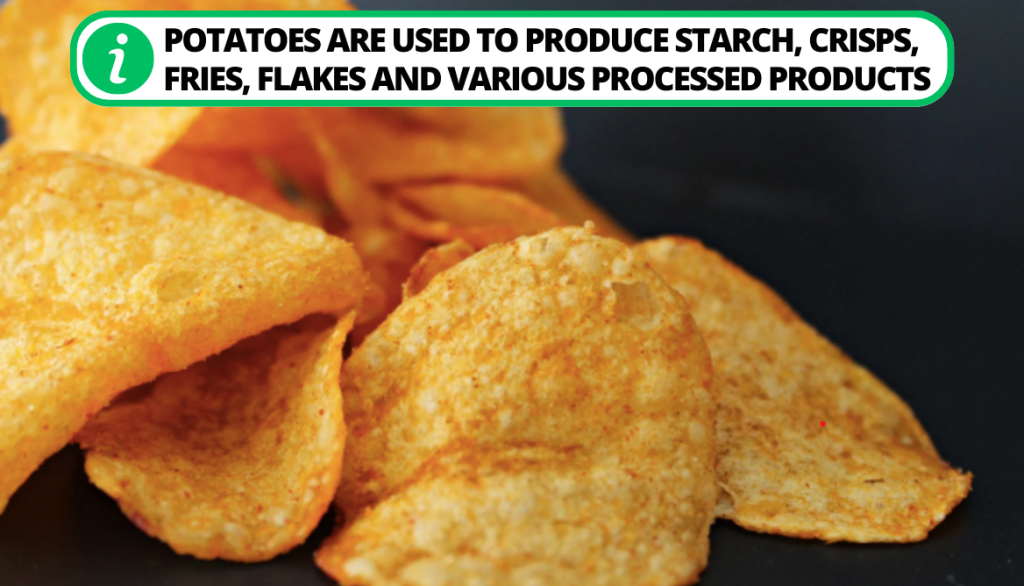
It is impossible to exaggerate the value of potatoes to agriculture. We can protect the future of this significant crop by addressing the yellowing of leaves through proactive actions, such as preserving nitrogen balance, managing water efficiently, and reducing insect and disease threats.
FAQ
Why are my potato leaves going yellow?
Yellow potato leaves can be caused by various factors, including nutrient deficiencies, diseases, pests, environmental stress, excessive sunlight overwatering or underwatering, etc.
How do you treat yellow potato leaves?
The underlying reason for the yellow potato leaves on your farm will determine how to treat them. It could entail managing pests and diseases, modifying watering techniques, managing nutrient deficits, and creating the right environmental conditions.
Why are my potato leaves turning yellow with black spots?
If your Potato leaves turn yellow with black spots. It can be a sign of fungal or bacterial diseases, such as early blight. To treat this issue, remove and destroy infected plants, apply fungicides or bactericides as recommended, practice crop rotation, and ensure proper moisture and spacing between potato plants.
Why are my potato leaves curling and yellowing?
Your potato plant’s leaves may curl and turn yellow due to aphid infestation, viral illnesses like the leafroll virus, herbicide damage, or environmental stressors.
To solve the problem, you must manage aphids, get rid of diseased plants, stay away from herbicides, and give your plants the right amount of shade and moisture.
Why are potato leaves dying?
Your Potato leaves can die due to diseases like late blight or bacterial wilt, water-related issues like root rot or stress from underwatering, severe pest infestations, and nutrient deficiencies or imbalances.
Prompt removal of infected plants, proper watering, pest control, and balanced fertilization can help you address the problem.
Conclusion
The yellowing of potato leaves can be caused by various factors, including natural processes, nutrient deficiencies, water-related issues, pests, and diseases. Identifying the underlying cause is crucial for implementing appropriate solutions and preventing further damage to the potato plants.
Potato leaf yellowing can be avoided and treated in a number of ways, such as by harvesting mature plants, ensuring adequate sunlight exposure, following proper watering procedures, addressing nutrient deficiencies, managing nutrient imbalances, preventing pests and diseases, and applying fertilizer correctly.
What strategies have you found most effective in preventing and treating yellowing potato leaves in your farming? Leave your response in the comment section. Thank you for reading.
- How to Get Potatoes to Sprout Eyes: Detailed Growing Guide with 3 Options - July 31, 2023
- Weight of a Medium Potato: Revealed in Detailed Guide - July 29, 2023
- Maris Piper Potatoes: 9 Substitutes You Should Know About - July 27, 2023
Hello! I’m Jessica Zander, a garden coach and consultant based in the Boston area (zone 6b), offering virtual consultations across the country and Canada.
I’ve been passionate about gardening since the early 1990s, and in 2022, I launched You Can Do It Gardening to empower individuals to feel more confident in their gardening endeavors.
Following a 30-year career in nonprofit finance and operations, I transitioned out of that field in mid-June of 2023 due to the growing demand for coaching services. Interestingly, my years of presenting financial statements to boards and finance committees proved to be valuable experience for teaching people about gardening! I enjoy sharing skills, providing guidance and suggestions, and collaborating efficiently with clients to make significant improvements to their outdoor spaces, both small and large. I also regularly teach at the Arlington Continuing Education and Cambridge Adult Education.
My approach is direct and practical, akin to Mary Poppins, but tailored to your garden. Clients find satisfaction in saving money and taking pride in their own gardening achievements.

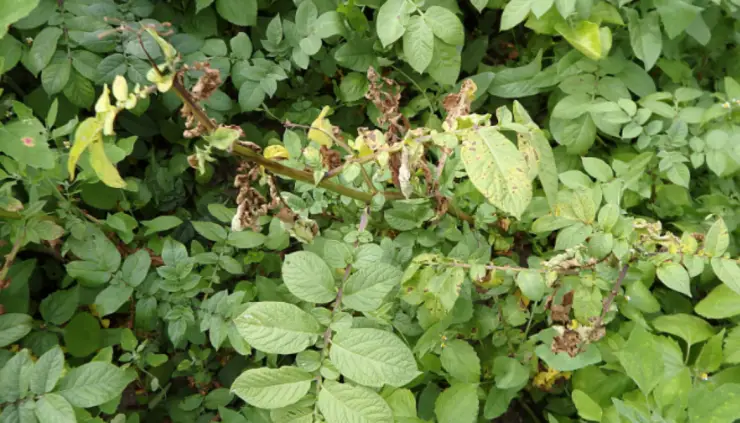

Add comment